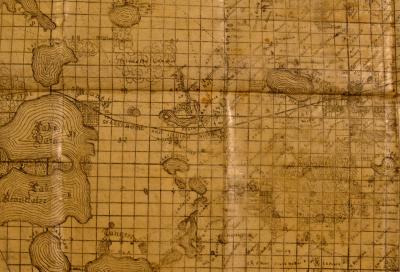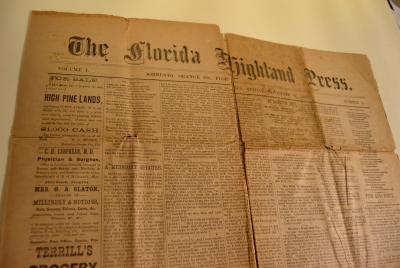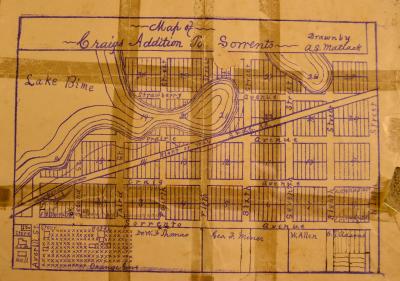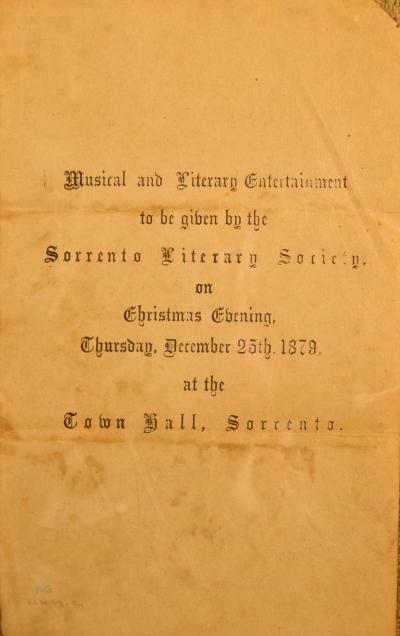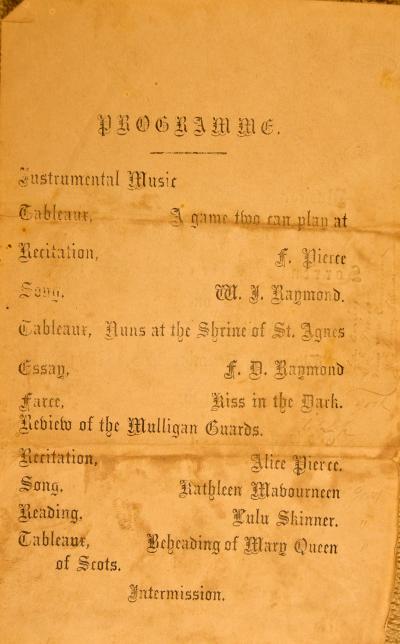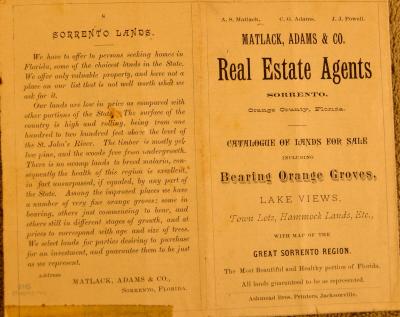Developers had great expectations for the settlement they were planning in western Orange County, Florida, in 1870. There was plenty of land for farms; the climate was good for citrus and for attracting northerners who, then as now, want to get away from winters. The community they dubbed Sorrento had a lot going for it, but not enough, it turned out, not “location, location, location.”
That was not obvious at first. Plotted out in 1870 east of Mt. Dora in an area that is now eastern Lake County, it seemed ideal for small subsistence farmers who could clear the land and grow, for example, pineapples for profit.
Ok, at first transportation was an issue, how to cheaply get the crop to market. In the mid 1880’s that first appeared to be solved with the planned arrival of the Leesburg and Indian River Railroad spur, seen on this map in the Library of Florida History Library.
To quote part of a 1997 Orlando Sentinel story by Ormund Powers:
“In 1885, the Leesburg & Indian River Railroad Co. Inc. started construction of a line from Leesburg to Titusville but consolidated with the Florida Railway & Navigation Co. before the year was out. Another 1895 development saw the Sanford & Lake Eustis Railway Co. raise $100,000 to build a route from Sanford to Lake Eustis, 30 miles away. That road extended from Sanford, the head of large steamboat navigation on the St. Johns River, to Tavares, the head of lake navigation, a distance of 30 miles.
An important spur went to Sorrento, 18 miles from Sanford and 12 from Tavares. The Florida Highland Press of Sorrento was overjoyed. In a front page story on Nov. 19, 1896, the editor said other companies had promised to build the line but had done little more than survey the route. It was then that Dr. J.N. Bishop of Sanford, president of the road, determined to push the work through and soon had a company formed with that object.''
It put Sorrento on the main line as ''a part of the new and popular railroad system of the state, the Jacksonville, Tampa & Key West Railroad (that) had gained the distinction of being the best route into South Florida. It is a part of the system of railroads that has the contract to carry the mail. The time from New York to Sanford is about 37 hours, and another half hour will place the mail at Sorrento.''
That quote from the Sorrento newspaper brings us back to the collection at the Library, which includes an 1886 edition of the paper, so fragile it can only be photographed in its archival box. The paper was a clear sign residents were determined to forge a community out of the farmland. And the editor of the paper was determined to spread their story nationwide.
In a story about the progress they had made since 1875 the editor wrote: “Ten years ago the first Yankees invaded the section of the country to find a place to settle and find a home. The forests were unbroken for miles, clearings few and far between, not a sign of civilization to be seen. The nearest post office was Sanford 20 miles away. What brought folks from large cities and towns of the north? It was the same high and beautiful pine hills that God had meant for man’s inheritance. The pine woods are here today, but broken at intervals by orange groves and thrifty houses settlers have built. They stayed and fought the battle for civilization that they knew would come.”
Flowery language indeed, to entice more northerners and some ‘hard facts’ to interest sober minded farmers; lists of the names of Sorrento farmers, how many acres they had under production and what was their crop.
But the idea of a community went beyond agricultural output. They build a post office, a school, a church, even a town hall.
They formed a literary society in the late 1870’s which held regular meetings to talk about the latest European and American literary works, and special events such as a Christmas pageant.
With all the entertainment you would expect in an 1870’s small town in America.
But, in the end it came down to a real estate deal, a marketing plan by investors to sell land, and a dream of a community where all could prosper. It never quite took off. Why? Likely some small elements of ‘location, location, location. It was next to Mount Dora, which was on a lake, had better rail service and appealed to tourists. Sanford was a few miles away and just grew faster, was a rail hub and steam ship port.

Courtesy Florida Memory
And then there was the big freeze of 1894-5. It virtually destroyed the central Florida citrus crop, and it hit Sorrento hard. Lots of people lost everything, and folks who had been there ten years or so gave up and went back north.
The neighborhood, officially a ‘census designated place’ in unincorporated Lake County, is still there, with fewer than 800 residents in the 2000 count. But the documents of its past can be of interest to genealogists, the land records include references to many people who where there for a few years, working for a dream that just needed a better location.

